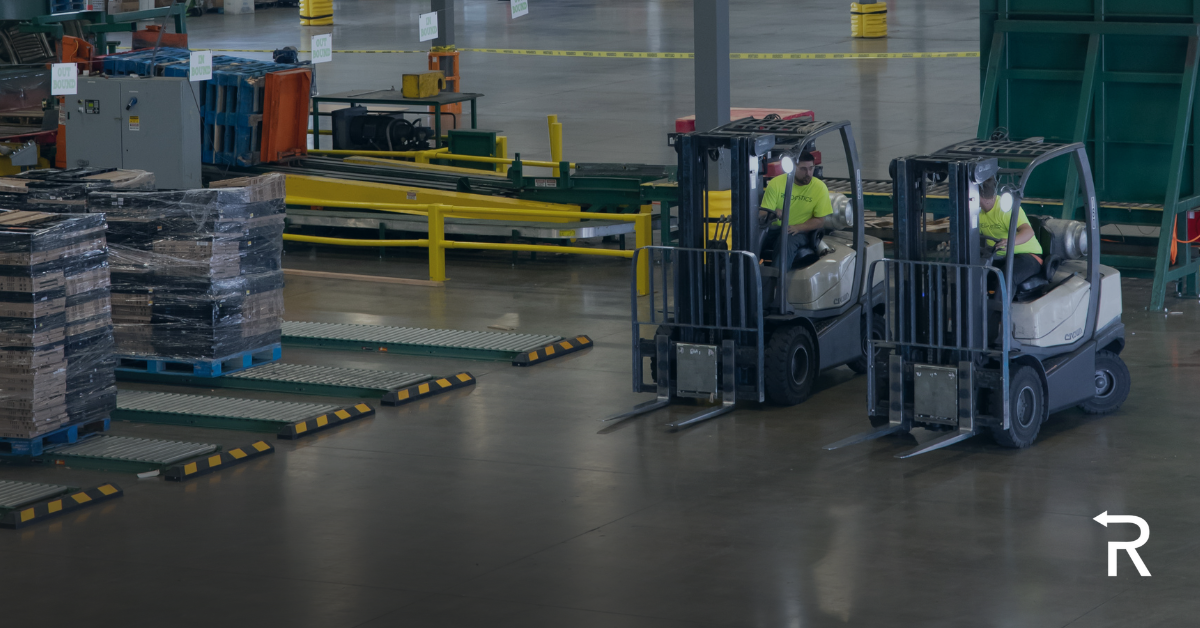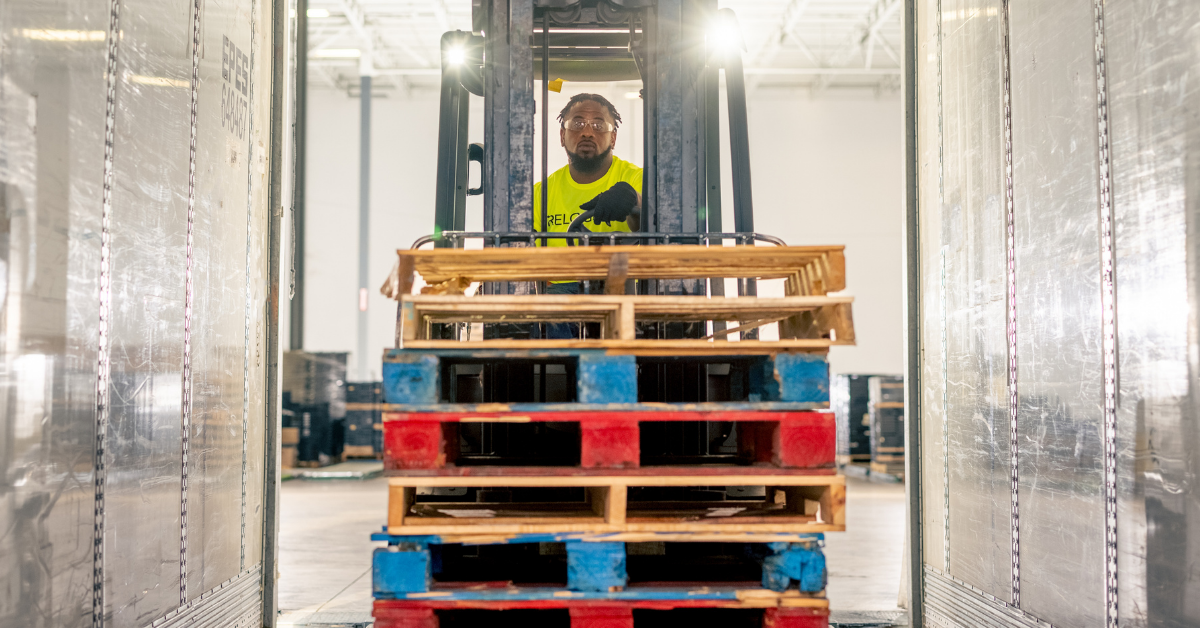A New Era for Logistics Companies

The supply chain world is in the midst of a fundamental shift. Gone are the days when logistics only meant moving products from point A to point B as quickly as possible. Today, efficiency is no longer defined solely by speed or cost; it’s also about sustainability, resource recovery, and long-term value. At the heart of this evolution is the circular economy, and for forward-thinking logistics companies, it’s not just a trend. It’s a transformation.
At Relogistics, we’ve embraced this shift head-on, helping our partners build more resilient and efficient operations through reverse logistics, reusable asset recovery, pallet recycling, and labor support. We believe sustainability and efficiency can go hand in hand, and logistics is the engine that can make circularity real.
What Is the Circular Economy?
At its core, the circular economy is designed to eliminate waste and keep resources in use for as long as possible. Unlike the traditional “take-make-dispose” model, the circular economy focuses on:
- Reusing materials instead of discarding them
- Repairing rather than replacing
- Recycling into new inputs
- Recovering value from assets that would otherwise be lost
This philosophy is gaining traction across industries, from manufacturing to retail, and logistics is at the center of the action. As supply chains grow more complex and consumer expectations evolve, logistics providers must rethink how materials move, return, and are reused.
If you're looking for a quick primer, our blog on The Circular Economy and the Role of Reusable Packaging in Sustainability provides more information.
Why Logistics Is Central to the Circular Economy
Every material, product, and return must move somewhere. That makes logistics the connective tissue in any circular system. The shift from linear to circular supply chains relies on logistics providers who can:
- Recover assets from distribution centers, retailers, or consumers
- Sort and process reusable packaging and pallets
- Manage returns efficiently through reverse logistic
- Track asset performance and location
- Reintroduce repaired or recycled goods into the supply loop
Without a strong logistics infrastructure, circularity stalls. However, when logistics companies build processes for reuse and return into their core offerings, they unlock new value for clients and new sources of operational efficiency.
Reverse Logistics: The Backbone of Circularity
If the circular economy is the philosophy, reverse logistics is the practice. It’s moving goods from their final destination back into the supply chain for reuse, refurbishment, or recycling.
At Relogistics, reverse logistics isn’t an afterthought; it’s a specialty. We help businesses recover everything from pallets and reusable containers to damaged goods and overstock inventory. Our national network ensures those items are inspected, sorted, repaired, and routed appropriately for maximum lifecycle extension.
Why it matters:
- Cost savings: Recovered goods reduce the need for new purchases
- Environmental impact: Less landfill waste, lower emissions from production
- Customer service: Faster, more reliable return and recovery options
- Inventory optimization: Returnable assets stay in circulation, not storage
Real-World Circular Applications in Logistics

So what does circularity look like on the warehouse floor or distribution dock?
Here are a few examples:
- Pallet recycling: Instead of discarding damaged pallets, we repair and recirculate them through our wood pallet repair services, reducing wood waste and purchase costs.
- Reusable packaging programs: Containers and totes are collected, cleaned, and returned to rotation, supporting long-term sustainability goals and vendor compliance programs.
- On-site labor teams: Our labor management solutions help businesses manage reverse flows in real time without adding internal headcount.
- Tracking through Velocity: Our Velocity platform provides end-to-end visibility into the asset lifecycle, allowing smarter redeployment and faster returns.
These efforts don't just make environmental sense, they improve the bottom line and increase supply chain resilience.
Circular Economy Trends Reshaping Logistics in 2025
A few years ago, the circular economy felt like a vision for the future. Now, it’s fast becoming a market expectation. According to a 2025 Forbes Business Council report, companies that adopt circular practices outperform peers in cost savings, brand reputation, and customer loyalty.
Key logistics-related trends include:
- Retailer demand for sustainable fulfillment
- OEM and CPG brands investing in closed-loop systems
- Expansion of ESG reporting requirements
- Increased automation of returns and asset tracking
As these trends evolve, logistics providers must offer flexible, scalable solutions that can adapt. That’s why Relogistics builds customized programs to support circular flows across industries, from grocery to general merchandise to manufacturing.
Benefits Beyond Sustainability
Let’s be clear: the circular economy isn’t just about “doing the right thing.” It’s about:
- Reducing procurement costs
- Minimizing transportation waste
- Decreasing product damage through higher-quality reusable assets
- Improving labor efficiency and warehouse organization
- Boosting supply chain visibility
In short, circular logistics is just good business. It strengthens your supply chain while aligning your brand with sustainability, a combination increasingly favored by customers, partners, and regulators.
How to Get Started with a Circular Logistics Model

Adopting a circular strategy doesn’t have to mean a total overhaul. Here are steps logistics leaders can take now:
- Audit existing packaging and pallet usage
- Identify returnable asset opportunities
- Set up reverse logistics routes for retrieval and recovery
- Partner with a provider like Relogistics for sorting, repair, and data management
- Track and report progress with sustainability and cost metrics
Need a framework? Our Supply Chain Audit Checklist can help you evaluate current gaps and opportunities.
Final Thoughts: The Circular Future Is Already Here
The circular economy is no longer a “nice to have”; it’s the next chapter in supply chain evolution. For logistics companies, that means reimagining how we recover, reuse, and redeploy resources to create value at every stage.
At Relogistics, we’re proud to help businesses integrate circularity into their supply chains with scalable solutions in reverse logistics, pallet and container management, and labor optimization. We don’t just move materials, we maximize their potential.
Let’s build a smarter, more sustainable supply chain together.
Contact us to learn how circular logistics can support your operational and environmental goals.
